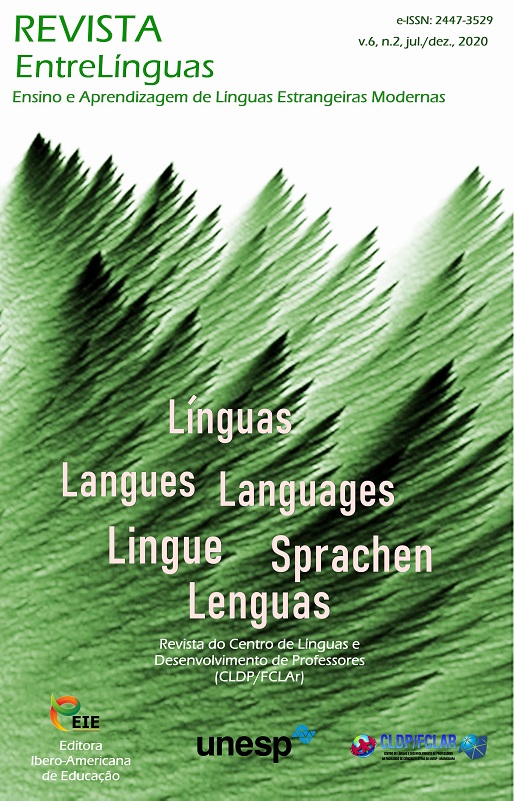A intrínseca relação entre atitude e crença: um estudo qualitativo com alguns estudantes universitários brasileiros de Inglês
DOI:
https://doi.org/10.29051/el.v6i2.13721Palavras-chave:
Crença, Atitude, Aprendiz, Língua inglesa.Resumo
Este artigo é sobre as atitudes e crenças de alguns estudantes universitários brasileiros. Assim, apresenta dados de um estudo qualitativo, cujo objetivo foi verificar a existência de uma relação entre atitude e crença. Os dados emergiram de um questionário aplicado com 91 estudantes universitários, de uma universidade brasileira, que estudavam inglês compulsoriamente. Para subsidiar o estudo, foram elaboradas categorias de análise: 1. Atitudes sustentam ou integram as crenças e 2. As crenças emergem como uma justificativa das atitudes. A análise dos dados apontou a existência de uma intrínseca relação entre atitude e crença. A relevância deste estudo reside na necessidade de entender ainda mais esta questão, já que, pelo que se sabe, até agora, apenas poucas pesquisas têm proposto refletir sobre essa relação assim como a compreensão dessa relação pode contribuir para a melhoria do ensino e da aprendizagem da língua inglesa.Downloads
Referências
ALLPORT, G. W. The historical background of modern social psychology. In: LINDZEY, G. (Ed.) Handbook of social psychology. Cambridge: Cambridge University Press, 1954. p. 3-56.
ANJOS, F. A. “Passei o semestre todo estudando o verbo to be": atitudes, (des)motivação e orientação para aprender inglês de alguns bacharelandos da UFRB. 2018. 254 f. Tese (Doutorado em Língua e Cultura) – Universidade Federal da Bahia (UFBA), Salvador, 2018.
ANJOS, F. A.; SCHEYERL, D. The need os language politics for the teaching of English in higher education in Brazil. Letras & Letras, Uberlândia, v. 35, p. 183-199, 2019.
BARCELOS, A. M. F. Metodologia de Pesquisa das Crenças sobre Aprendizagem de Línguas: Estado da Arte. Rev. Brasileira de Linguística Aplicada, Belo Horizonte, v. 1, n. l, p. 71-92, 2001.
BARCELOS, A. M. F.; VIEIRA-ABRAHÃO, M. H. (org.). Crenças e ensino de línguas: foco no professor, no aluno e na formação de professores. Campinas, SP: Pontes, 2006.
BORG, M. Teachers’ beliefs. ELT Journal, Oxford University Press, v. 55, n. 2, p. 186-188, 2001.
BORG, M. Learning to Teach: CELTA trainees' beliefs, experiences and reflections. 2002. 469 f. Tese (Doutorado) – The University of Leeds School of Education, set. 2002.
CONNORS, M. H.; HALLIGAN, P. W. A cognitive account of belief: atentative road map. Frontiers in psychology, v. 5, p. 1-14, 2015.
GARBUIO, L. M. Crenças sobre a língua que ensino: foco na competência implícita do professor de língua estrangeira. In: BARCELOS, A. M.; VIEIRA ABRAHÃO, M. H. Crenças e ensino de línguas: foco no professor, no aluno e na formação de professores. São Paulo: Pontes, 2006. p. 87-104.
GARDNER, R. C. Social Psychology and second language learning: the role of attitudes and motivation. Edward Arnold, 1985.
HOSSEINI, S.B.; POURMANDNIA, D. Language learners´attitudes and beliefs: brief review of the related literature and frameworks. International Journal on new trends and education and their implications, v. 4, n. 4, p. 63-74, 2013.
KALAJA, P.; BARCELOS, A. M. F. Beliefs about SLA: new research approaches. 2. ed. Springer, 2006.
KUMARAVADIVELU, B. Language teacher education for a global society. a modular model for knowing, analyzing, recognizing, doing and seeing. Routledge, 2012.
MACKENZIE, R. M. The social psychology of english as a global language. Attitudes, awareness and identity in the Japanese context. United Kingdom: Northumbria University, 2010.
MARSH, K. L.; WALLACE, H. M. The Influence of Attitudes on Beliefs: Formation and Change. In: ALBARRACÍN, D.; JOHNSON, B. T.; ZANNA, M. P. (Eds.), Handbook of Attitude and Attitudes Change. Mahwah, NJ: Erlbaum, 2004. p. 2-66.
PAJARES, M. F. Teachers’ beliefs and educational research: Cleaning up a messy construct. Review of Educational Research, v. 62, n. 3, p. 307-332, 1992.
SPAWA, C. M. C.; HASSAN, F. “I doesn’t know English”: Beliefs and Practices in the Teaching of Speaking in ESL Classroom. Pertanika J. Soc. Sci. & Hum, v. 21, n. 2, p. 449-460, 2012.
Downloads
Publicado
Como Citar
Edição
Seção
Licença
Os manuscritos aceitos e publicados são de propriedade da Revista EntreLínguas. Os artigos publicados e as referências citadas na Revista EntreLínguas são de inteira responsabilidade de seus autores.
Transferência de direitos autorais – autorização para publicação
Caso o artigo submetido seja aprovado para publicação, já fica acordado que o(s) autor(es) autoriza(m) a UNESP a reproduzi-lo e publicá-lo na EntreLínguas, entendendo-se os termos “reprodução” e “publicação” conforme definição respectivamente dos incisos VI e I do artigo 5° da Lei 9610/98. O artigo poderá ser acessado pela rede mundial de computadores (Internet), sendo permitidas, a título gratuito, a consulta e a reprodução de exemplar do artigo para uso próprio de quem a consulta, desde que haja a citação ao texto consultado. Essa autorização de publicação 328 EntreLínguas, Araraquara, v. 1, n .2, p. 323-328, jul./dez. 2015 não tem limitação de tempo, ficando a UNESP responsável pela manutenção da identificação do(s) autor(es) do artigo. Os artigos publicados e as referências citadas na Revista EntreLínguas são de inteira responsabilidade de seus autores.











